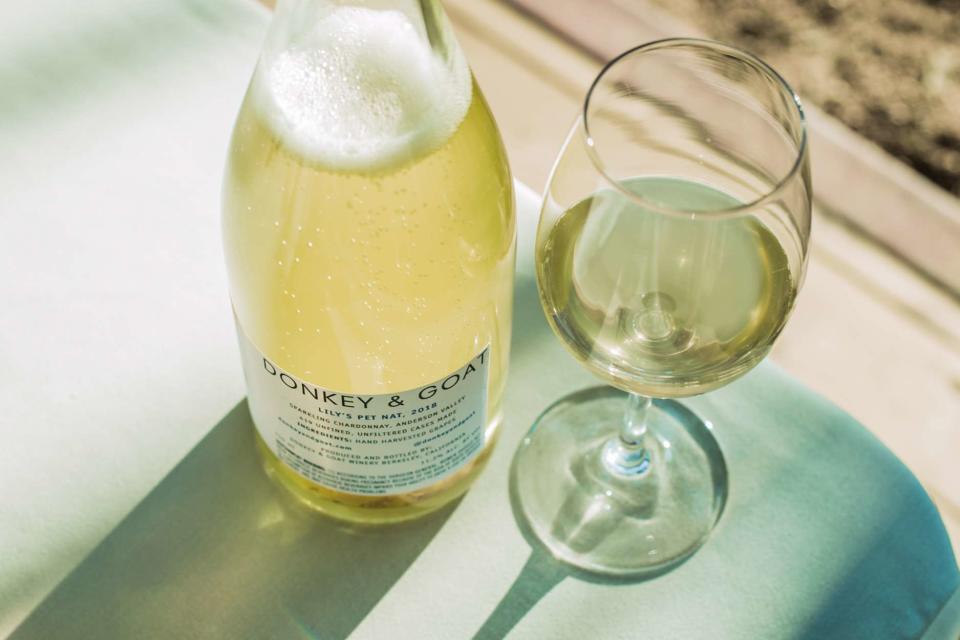What Exactly Is a Pét-Nat?

Pét-nat is an abbreviation for "pétillant naturel"—a French term that roughly translates to "naturally sparkling."
Maybe you already knew that. After all, pét-nat has been hip for a few years now; all the cool kids are drinking it. But even if you've sampled a few bottles of the stuff, you'd be forgiven for not knowing exactly what qualifies as pét-nat, or how these sparkling wines differ from other types of bubbly.

Ryan Langsdorf
How Pét-Nats Are Made
"Pét-nat is a wilder version of a sparkling wine like Champagne," says Jared Brandt, owner of Berkeley, California's Donkey & Goat Winery, which has produced pét-nat since 2010. "When people ask, I tell them pét-nat is a wine that we bottle during initial fermentation, and the sugars from the grapes provide the bubbles."
As you may know, during alcohol fermentation, yeasts eat sugar. The byproducts of this process are alcohol and carbon dioxide. In non-sparkling wines—your Chardonnays, Pinot Noirs, etc.—most or all fermentation occurs before bottling, so there is no trapped C02, and therefore no bubbles.
Pét-Nat vs. Champagne
Traditional Champagne (and other sparkling wines like Crémant and Cava) are made by combining one or more still dry wines—basically, finished wines that have already undergone fermentation—with a small amount of yeast and sugary liqueur. This combination is bottled and aged, and the yeast eats the sugar in the liqueur. This second, in-bottle fermentation produces the trapped carbon dioxide that gives these sparkling wines their bubbles. (Prosecco and other less-expensive sparkling wines often undergo secondary fermentation in large tanks, rather than in bottles. In some cases, C02 is simply pumped into a finished wine before bottling.)
"Pét-Nat is like a junior version of this really complicated Champagne process," says Steve Hall, co-owner of Spencer, a restaurant and natural-wine shop in Ann Arbor, Michigan. Rather than blending different dry wines and putting them through a second round of fermentation and aging, pét-nat is bottled while still undergoing its first round of fermentation. The French call this process "methode ancestral," and it's likely been around far longer than other, more complex methods of producing sparkling wine.

Kirsten Kaiser
That's not the only difference between pét-nat and traditional bubbly. While classic sparkling wines are typically made from a narrow range of grapes, Hall says winemakers today are making pét-nat with all kinds of unusual and interesting grape combinations. "People from a lot of different [winemaking] regions are experimenting with these cool sparkling projects," he says.
Compared to Champagne and other sparkling wines, Brandt says pét-nat is unpredictable. "We have no control once it's in the bottle, so every bottle will be a little different," he says. When a pét-nat is first released, he says it may still be a tad sweet—the result of some residual sugar that hasn't yet undergone fermentation. "It tends to get drier [as time passes], and to speed that up you can put a bottle in a sunny window for a few days." (The sunlight helps encourage in-bottle fermentation.) He also says that a pét-nat's bubbles often become softer and smaller as it ages. But pét-nats aren't meant for long cellaring. "I generally suggest that people drink them within three months of buying," he says.
Pairing Pét-Nats
Asked when and how to serve them, Hall says pét-nat tends to be a fun, versatile food wine. "I think all sparkling wines go surprisingly well with food, especially lighter dishes," he says. "Pét-nat doesn't have the same refinement or delicacy as Champagne, but they also don't break the bank the way Champagne does." He says most pét-nats tend to be fairly low in alcohol—usually well under 13% ABV— and so they're usually refreshing and great for afternoon or evening drinking. Many are also unfined and unfiltered, and may include some leftover yeast cells, which can lead to a slightly cloudy or hazy appearance. (All this is fine to drink.)
How You Know It's a Pét-Nat
Identifying them can be a little tricky. While some producers helpfully put "pét-nat" or "pétillant naturel" right on the label, others don't. They may also use terms like "bottle fermented," "methode ancestral," or, if Italian, "col fondo," which is basically pét-nat Prosecco. "If you see sediment and a crown cap"—meaning the kind of top on an old Coke bottle—"it's probably pét-nat," Brandt offers. Ask your friendly wine shop owner to point you in the right direction.
5 Pét-Nats We Love
Donkey & Goat "Lily's" Pét-Nat ($35)
First made in 2011, this pét-nat (named after Brandt's daughter) is a nice introduction to the style for those used to traditional sparkling wines. Made with Chardonnay grapes, this fruit-and-flower-forward wine has enough earthy, spicy notes to give it balance and intrigue.
Les Capriades "Pét-Sec" ($32)
This Chenin Blanc-dominant sparkling wine comes from a producer in the Touraine region of France's Loire Valley—ground zero for the pét-nat resurgence. It's an off-dry (meaning semi-sweet) and acid-forward punch of melon and white-fleshed fruits. This is a killer porch-sipper on its own, and a pleasant companion with apps and salads.
Day Wines Mamacita! Pét-Nat ($30)
This appealingly funky, yeasty, give-me-more sparkler from Oregon's Day Wines is all kinds of fun. Made from Malvasia Bianca and Muscat, it's fruity, floral, and a little spicy. It's the vinous equivalent of cannonballing into a pool.
Costadilà Bianco Col Fondo ($25)
This sparkling orange wine is an amalgam of zeitgeisty, alt-wine fads. But don't let its on-trendiness scare you away. Made from a blend of several grapes—most prominently Glera, the grape used to produce Prosecco—this unfiltered sparkling wine is herbaceous but also savory. Stock up now and save what you buy for lazy summer afternoons.
William Chris Pét-Nat Rosé 2019 ($25)
Made primarily with Sangiovese and Mourvèdre, this pink pét-nat from Texas's William Chris Vineyards is soft and light, and turns down the outré characteristics that delight natural wine fans but can be off-putting for some wine drinkers.

